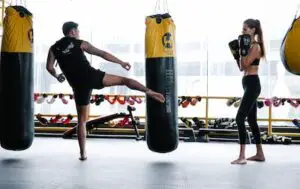As krav maga and kapap become more popular, people often wonder what the difference is between these two self-defense styles. Both of these self-defense systems originated in Israel and have become increasingly popular worldwide in recent years. While there are similarities between these two styles, there are also significant differences in their approaches to self-defense. In this article, we will explore the differences between krav maga and kapap in detail.
What is krav maga?
Krav maga is a modern martial art that originated in Israel, developed by the Israeli army before Israel became an independent nation. Krav maga is known for its practical self-defense techniques that are intended to help people defend themselves against real-world situations that could potentially be life-threatening. Krav maga is designed to be simple and effective, allowing people to quickly learn how to defend themselves in a real-world scenario.
What is kapap?
Kapap, or Krav Panim El Panim, is an Israeli martial art that has been used by the Israeli security forces since the 1940s. Kapap has recently gained popularity as a self-defense system around the world due to its practical approach to self-defense. Kapap is a system that incorporates elements of karate, judo, jujitsu, and western boxing.
What are the differences between krav maga and kapap?
Krav Maga and Kapap are both Israeli martial arts systems that focus on self-defense and combat techniques. While they share some similarities, there are also differences between the two. Here are some key distinctions:
- Origins: Krav Maga is a well-known system developed by Imi Lichtenfeld in the 1940s. It was initially created for the Israeli military and has since been adapted for civilian self-defense. Kapap, on the other hand, stands for “Krav Panim el Panim,” which means “face-to-face combat” in Hebrew. Kapap is an older system, developed prior to Krav Maga, and was used by Jewish paramilitary organizations in pre-state Israel.
- Development: Krav Maga has undergone more formalized development over the years and is taught through various organizations worldwide. It has a standardized curriculum and belt ranking system. In contrast, Kapap has a less structured approach, often adapting techniques based on the specific needs of the individuals or organizations using it.
- Focus: Krav Maga places a significant emphasis on practical self-defense techniques that can be used in real-world situations. It incorporates elements from different martial arts, including striking, grappling, and defenses against various attacks. Kapap also focuses on self-defense but has a broader scope, including elements of both armed and unarmed combat, as well as fieldcraft and survival skills.
- Techniques and Training: Krav Maga techniques are often designed to be simple, efficient, and easy to learn. The training emphasizes rapid responses and realistic scenarios, preparing practitioners for potentially dangerous situations. Kapap incorporates a wider range of techniques, including hand-to-hand combat, knife fighting, stick fighting, and more. Kapap training may also include elements of traditional martial arts and combat fitness.
- Application: Krav Maga is commonly taught to military and law enforcement personnel worldwide due to its effectiveness in real-life situations. It has gained popularity among civilians as well. Kapap, while also applicable to military and law enforcement training, has been less standardized and is generally considered less mainstream than Krav Maga.
What are the training methods used in krav maga?
Krav maga training often involves role-playing scenarios to help people better understand how to react in real-world situations. This approach emphasizes quick thinking and improvisation over memorization of specific techniques. Krav maga also incorporates drills that simulate real-world scenarios to help people better prepare for unexpected situations.
What are the training methods used in kapap?
Kapap training often involves learning various techniques and training to perfect them. Kapap training emphasizes physical fitness and strength training, as well as developing a greater awareness of one’s surroundings to identify and respond to potential threats. Kapap also emphasizes the importance of aggression and using an opponent’s momentum against them.
Which style is better suited for which person?
Both krav maga and kapap have their strengths and weaknesses, and their suitability will depend on an individual’s preferences and fighting style. Krav maga is often seen as a more modern self-defense system that emphasizes striking and quick thinking, whereas kapap is often seen as a more traditional martial art that values strength and physical fitness. Ultimately, the best system for an individual will depend on their needs and the scenarios they might face.
Conclusion
In conclusion, while kapap and krav maga may seem similar on the surface, they have different approaches to self-defense. Krav maga is seen as a more modern self-defense system, while kapap is seen as a more traditional martial art. Krav maga emphasizes striking and quick thinking, whereas kapap values strength and physical fitness. Ultimately, both systems have their strengths and weaknesses, and the decision between which one to choose will depend on individual needs.





